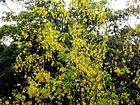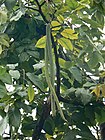Note: This is a project under development. The articles on this wiki are just being initiated and broadly incomplete. You can Help creating new pages.
Cassia fistula - Aragvadha
Cassia fistula known as the golden rain tree. It is a flowering plant. The species is native to the Indian subcontinent and adjacent regions of Southeast Asia. It ranges from southern Pakistan eastward throughout India to Myanmar and Thailand and south to Sri Lanka. This tree is belongs to Caesalpiniaceae.[1]
Uses
Fever, Skin diseases, Rheumatic diseases, Cervical lyrnphadenitis, Cardiac diseases, Worm Infestations, Abdominal pain.
Parts Used
Chemical Composition
Pulp of the pod contains anthraquinone glycosides, sennosides A and B, rhein and its glucoside, barbaloin.[2]
Common names
| Language | Common name |
|---|---|
| Kannada | ಕಕ್ಕೆಮರ Kakkemara, ಕೊಂದೆ Konde |
| Hindi | Amaltas |
| Malayalam | Konna, Kritamalam |
| Tamil | Sarakonrai, Sarak konnai, Sarak kondi, Sharakkonrai |
| Telugu | Rela |
| Marathi | Bahava, Garamala, Amaltas |
| Gujarathi | Garamala, Garamalo |
| Punjabi | Amaltas |
| Kashmiri | Kriyangal Phali |
| Sanskrit | Krathamaala, Vyaadighata, Shampaaka |
| English | Indian Laburnum, Purging cassia |
.[3]
Properties
Reference: Dravya - Substance, Rasa - Taste, Guna - Qualities, Veerya - Potency, Vipaka - Post-digesion effect, Karma - Pharmacological activity, Prabhava - Therepeutics.
Dravya
Rasa
Tikta (Bitter), Madhura (Sweet)
Guna
Guru
Veerya
Ushna (Hot)
Vipaka
Madhura (Sweet)
Karma
Recana
Prabhava
Habit
Identification
Leaf
| Kind | Shape | Feature |
|---|---|---|
| Alternate | Pinnate | 20 to 40 cm long pinnate, leaflets in 4 to 6 pairs, colour greenish, ovate with numerous nerves |
Flower
| Type | Size | Color and composition | Stamen | More information |
|---|---|---|---|---|
| Unisexual | 5 petals | Bright yellowish | 10 stemens | Lax pendulous racemes flowering season February to April |
Fruit
| Type | Size | Mass | Appearance | Seeds | More information |
|---|---|---|---|---|---|
| Cylindrical pod | 30 to 45cm long | Brownish black in colour | Flat, testa very hard, smooth, numerous, present between the pulp | {{{6}}} |
Other features
List of Ayurvedic medicine in which the herb is used
Where to get the saplings
Mode of Propagation
How to plant/cultivate
Seed. The seeds have a hard seed coat and germination is improved by mechanical scarification or treatment with concentrated sulphuric acid for at least 45 minutes.[6]
Commonly seen growing in areas
Photo Gallery
References
- ↑ Karnataka Aushadhiya Sasyagalu By Dr.Maagadi R Gurudeva, Page no:57
- ↑ Phytochemistry
- ↑ Common name
- ↑ Cite error: Invalid
<ref>tag; no text was provided for refs namedLeaf - ↑ Ayurvedic preparations
- ↑ Cultivation details
External Links
- Pages with reference errors
- Ayurvedic Herbs known to be helpful to treat Fever
- Ayurvedic Herbs known to be helpful to treat Skin diseases
- Ayurvedic Herbs known to be helpful to treat Rheumatic diseases
- Ayurvedic Herbs known to be helpful to treat Cervical lyrnphadenitis
- Ayurvedic Herbs known to be helpful to treat Cardiac diseases
- Ayurvedic Herbs known to be helpful to treat Worm Infestations
- Ayurvedic Herbs known to be helpful to treat Abdominal pain
- Herbs with Fruit pulp used in medicine
- Herbs with Bark used in medicine
- Herbs with Root used in medicine
- Herbs with common name in Kannada
- Herbs with common name in Hindi
- Herbs with common name in Malayalam
- Herbs with common name in Tamil
- Herbs with common name in Telugu
- Herbs with common name in Marathi
- Herbs with common name in Gujarathi
- Herbs with common name in Punjabi
- Herbs with common name in Kashmiri
- Herbs with common name in Sanskrit
- Herbs with common name in English
- Habit - Herb
- Index of Plants which can be propagated by Cuttings
- Index of Plants which can be propagated by Layering
- Index of Plants which can be propagated by Vegetative
- Herbs that are commonly seen in the region of Tropical area
- Herbs
- Fabaceae







